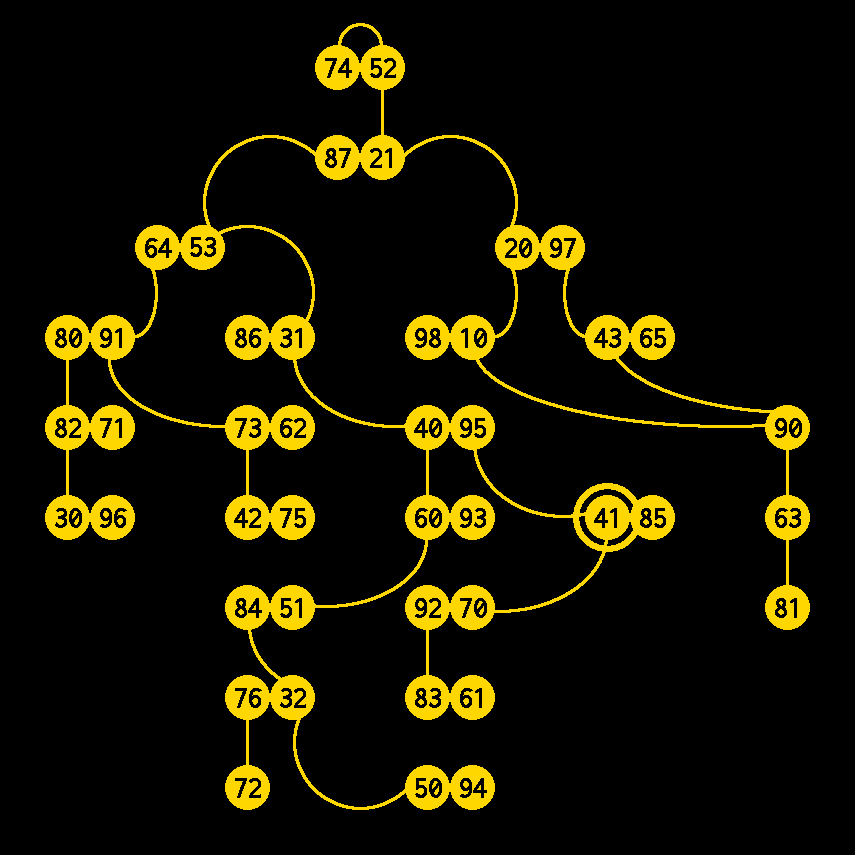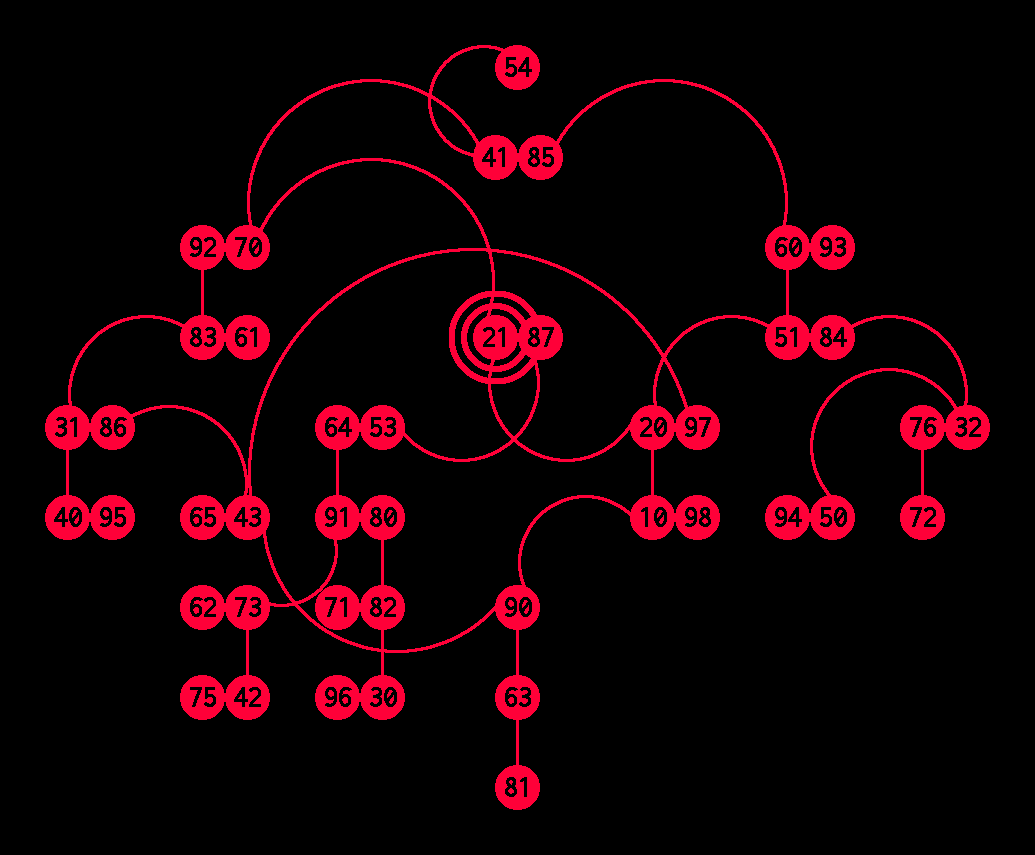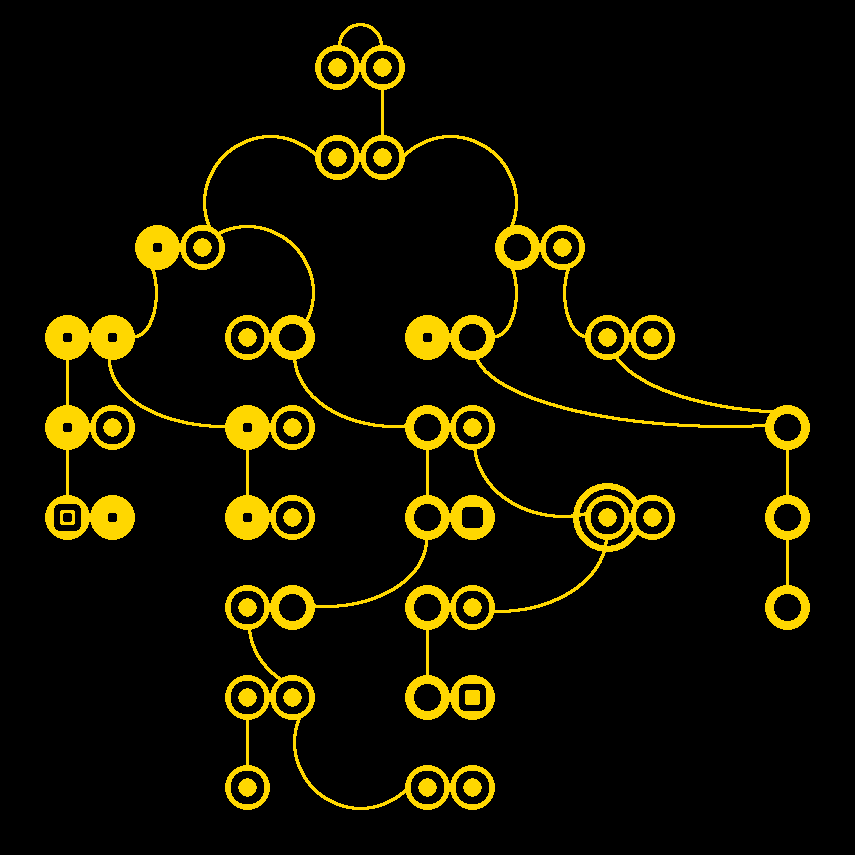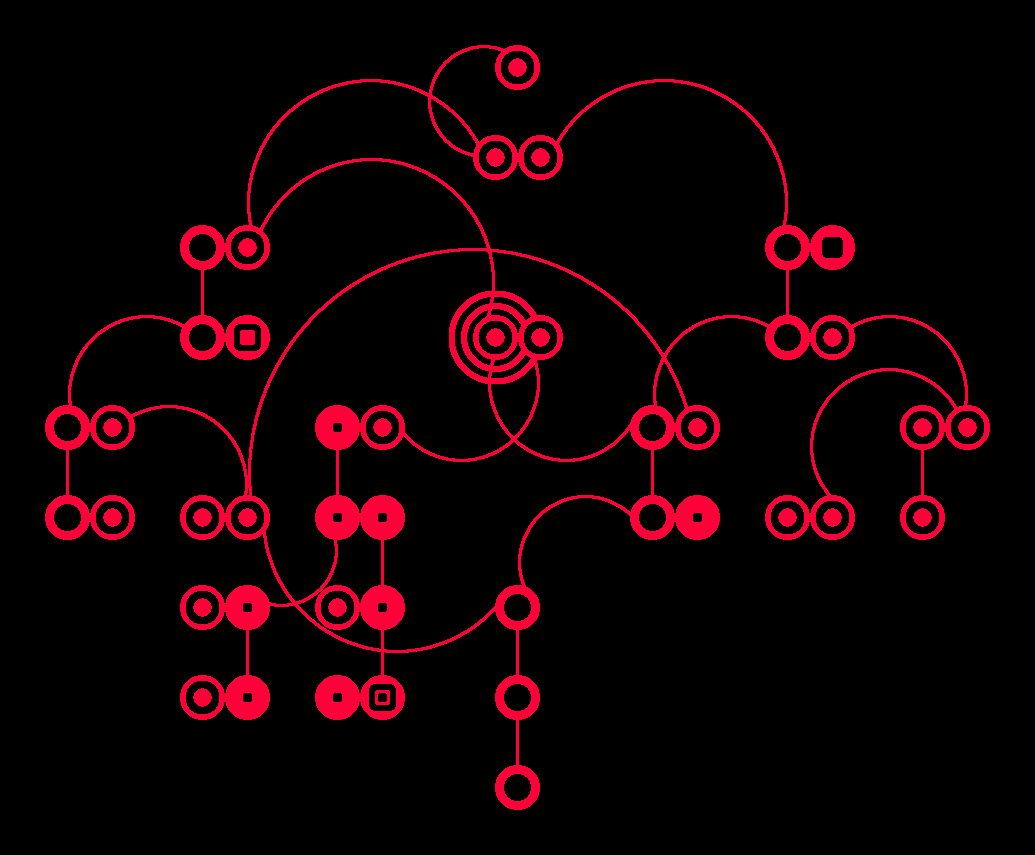The Akkoaic Hiernomicon
Lillian Patch - 𝍊𝌦
Click. We touch, two parallel flows of matter; my number coincides with yours; we slough off separate forms. A lemur is always indexed twice, once by the twin of its zones and once by its profundity—net-span and mesh-number. A lemur's span, its twin of zones, is a twin within a twin, pressed up to its mesh which is the cipher of another span. Each lemur runs its hands along the back of another, although sometimes this other is itself. When the two digits of a mesh-tag diverge, it is trivial to take them as a span; when they converge, one needs only to add them and to pair their sum with 0; when the sum they form is 0 too, the 0 it must pair with is 9. The lemurs spin themselves out readily, only ever half in themselves: a web, a labyrinth, and a river flowing downhill.
When a mesh-tag is ciphered, it loses information, at a minimum forgetting its order and at times forgetting more. A net-span cannot reliably be linked to a single mesh, and so the transition from the latter to the former is irreversible. The lemurs are active and subtle, and not every change can be revoked. But the lemurs are patient, too, and do not always have fixed beginnings and ends. Just as each lemur has a click, each lemur has a cross. For each zone of a net-span exists as part of two, as a zone in syzygy: each can be substituted with the zone in combination with which it sums to 9. Meeting across the vast abrupt with neither arriving first, the non-syzygetic lemurs meet as though they were the zones of a syzygy. The syzygies, like the lemurs who click themselves, meet themselves in a shuffled form, reflected back across the dark mirror. To click and to cross, two separate forms of touch by which no lemur is alone. Two separate forms..?
Akko, on the black, dry sand. Imagine her alone. She reaches out for another like her in both the ways she can. Click: as 7::4 she is the 25th. Cross: from 7 comes 2 and from 5 comes 4. Akko rolls across the shoulders of the world and brings together click and cross; there is no difference of the two in her, in her meeting with Kei. Nothing of the lemurs can be kept apart; by some coincidence, they always seem to coincide. Here is a kind of beginning.
Taking any lemur of the decimal labyrinth as a starting point and reaching out to the others by clicks and crosses, all but three lemurs will assuredly be found. Each lemur except these three is either clicked by some other attainable lemur or crossed by a lemur which can be viably clicked. Two of the three exceptions are Akko and Kei. Akko cannot possibly be the cipher of any mesh because the mesh-tags end at the 44th and she is at least 47. Her only hope of attainment, then, must derive from her cross, from Kei—but Kei is only clicked by Akko herself, and so there is no route to either of them. The other of the three exceptions is Koa, whose net-span is 5::4. Koa is a syzygy and so she can only cross herself, but unlike the other four syzygies, her most diminutive ordering, 45, exceeds the limit of the mesh. Akko and Koa—it is for these two that the Temple adherents call themselves "Akkoa" and "Akkoaic." Akkoa is AQ 84, for all the 84 paths; Akkoaic is AQ 114, which it shares with "lemur." Between Akko and Koa unfold all of the lemurs and the paths between them, bearing in mind that the procession of Kei is immanent in the cross which clicks her.

Crosses belong to the order of instants, coming into existence all at once. Clicks belong to the order of sequences, of transitions between instants. From this asymmetry, the Akkoa derive the possibility of ranking instants, with each click required to reach it incrementing its rank by 1. The Akkoaic Hiernomicon is in essence the culmination of this insight. In Temple doctrine, the procession from Akko-Kei is used exclusively, being the most comprehensive; this procession is said to be Akkoaic because the hole left by the singular exclusion of Koa is a presence as significant as Akko's. Sorted by their number of requisite clicks, the lemurs of the Hiernomicon separate into nine generation, which the Akkoa number from 1, for Akko-Kei, to 9. Koa, which cannot be reached, is taken to reside in generation 0, and so the full range of Subdecadence ranks and decimal zones are at play in the system. Here again is another click of a different kind as the three systems coincide: the Akkoa view the Hiernomicon as immanent in the Decadological ranks, and form their understanding of the zones through the lemurs which swarm in their generations. "The jewel is the spider is the web."

But this is not the only perspective on the Hiernomicon. To the Cult of Cudle, which emerged from Akkoaic schismatics, what the Temple calls the Hiernomicon is only half of its doubleness, only "the Procession of Gold." What it leaves unspoken is "the Procession in Red," the ordering of the generations if Akko and Kei are assigned to the 0th generation and Koa is assigned to the 1st. Remarkably, this "other lip of the Hiernomicon" also works out such that it reaches every attainable lemur within 8 clicks, and so has 9 generations plus 0; the two processions willingly coincide. It is through this coincidence that the Akkoa derive a new mode of contact for the lemurs: ESC, short for Escalade, which compares the position of a lemur in one procession to its position in the other. Coincidentally, these positions are never equal, and so because each procession moves from 0 to 9, the ESC value of any lemur is also a lemur. For the lemurs which define the two processions by either being placed in the 1st or 0th generation, this lemur is by definition 1::0. Every Lemurian ritual begins with Yoll, and the Hiernomicon is no exception, says the Cult.

Depictions of the Hiernomicon do not usually portray all the connections the lemurs form by their clicks, but rather, only those clicks which are involved in producing a new generation. The Akkoa refer to a lemur as “gold” if its click has this function in the Procession of Gold, and as “red” if its click does so in the Procession in Red. Some lemurs, like Susi, are both red and gold, while others, like Jitu, are neither; obviously Koa is exclusively red and Akko and Kei are exclusively gold. These qualifications of the lemurs are added to the older Akkoaic notion of click-types, which is independent of any particular ordering of generations. Akkoaic click-types are based on the insight that, by following the sequence of clicks of any lemur, one always arrives at one of four locations: Cail, 6::1; Zhin, 9::3; Ezh, 3::0; or a loop of eleven lemurs with no discernible beginning or end. Cail and Zhin are only clicked into by themselves, but both Ezh and the loop of eleven are fed by a number of other lemurs. As such, the Akkoa divide the lemurs into six click-types: Cail, Zhin, Ezh, those in the loop of eleven, those which feed Ezh, and those which feed the loop. The formal depictions of the Akkoaic Hiernomicon in both the Temple and the Cult use markings to portray these click-types in place of the relevant lemur’s net-span, which is shown in simplified versions.

It is by using these click-types that the Arbor of the Heart, an independent collectivity within the Cult of Cudle, portrays the lemurs as a garden and a tree ripe with fruit. Re-imagining the myth of Eden, it treats the elevenfold loop of lemurs as the garden in which Ezh, the tree of life, is situated, while Cail and Zhin stand exiled outside its perimeter. To find a cornucopia amid the lemurs, each which leads to the garden or to the tree and is not itself clicked or is clicked more than once is thought to initiate a new fruit, whose name is determined by aquivalence. Lemurs inherit the fruit of the lemurs that click them, iterating the number of that fruit up by one, until the garden or the tree is reached, at which point infinite recurrence takes hold. The dryads suppose that St. Vincent Millay was the original discoverer of this system, and that “First Fig” and “Second Fig” are fragments of a lost system of twenty-one different fruits, its longest thread being the Seven Nannyberries. These seven comprise the Arbor’s conception of the week, which ends in the unlimited abundance of the tree of life. Beginning on the first day with Eku, whose epithet is “Eden,” we finally come to rest on the seventh day in Ezh.
“Only man thinning out his kind
sounds through the Sabbath noon, the blind
swipe of the pruner and his knife
busy about the tree of life...”
Robert Lowell, "Walking Early Sunday Morning"
